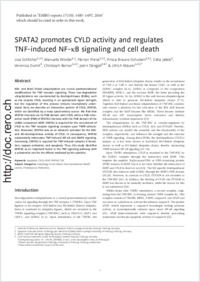SPATA2 promotes CYLD activity and regulates TNF‐induced NF‐κB signaling and cell death
- Schlicher, Lisa Institute of Molecular Medicine and Cell Research, Albert‐Ludwigs‐University Freiburg, Germany - Spemann Graduate School of Biology and Medicine (SGBM), Albert‐Ludwigs‐University of Freiburg, Germany - BIOSS, Centre for Biological Signaling Studies, Freiburg, Germany
- Wissler, Manuela Institute of Molecular Medicine and Cell Research, Albert‐Ludwigs‐University Freiburg, Germany
- Preiss, Florian Institute of Molecular Medicine and Cell Research, Albert‐Ludwigs‐University Freiburg, Germany - Spemann Graduate School of Biology and Medicine (SGBM), Albert‐Ludwigs‐University of Freiburg, Germany
- Brauns‐Schubert, Prisca Institute of Molecular Medicine and Cell Research, Albert‐Ludwigs‐University Freiburg, Germany - Spemann Graduate School of Biology and Medicine (SGBM), Albert‐Ludwigs‐University of Freiburg, Germany
- Jakob, Celia Institute of Molecular Medicine and Cell Research, Albert‐Ludwigs‐University Freiburg, Germany
- Dumit, Veronica Core Facility Proteomics, Center for Biological Systems Analysis, Freiburg, Germany
- Borner, Christoph Institute of Molecular Medicine and Cell Research, Albert‐Ludwigs‐University Freiburg, Germany - Spemann Graduate School of Biology and Medicine (SGBM), Albert‐Ludwigs‐University of Freiburg, Germany - BIOSS, Centre for Biological Signaling Studies, Freiburg, Germany
- Dengjel, Jörn BIOSS, Centre for Biological Signaling Studies, Freiburg, Germany - Core Facility Proteomics, Center for Biological Systems Analysis, Freiburg, Germany - Department of Biology, University of Fribourg, Switzerland
- Maurer, Ulrich Institute of Molecular Medicine and Cell Research, Albert‐Ludwigs‐University Freiburg, Germany - Spemann Graduate School of Biology and Medicine (SGBM), Albert‐Ludwigs‐University of Freiburg, Germany - BIOSS, Centre for Biological Signaling Studies, Freiburg, Germany
-
01.10.2016
Published in:
- EMBO reports. - 2016, vol. 17, no. 10, p. 1485-1497
English
K63‐ and Met1‐linked ubiquitylation are crucial posttranslational modifications for TNF receptor signaling. These non‐degradative ubiquitylations are counteracted by deubiquitinases (DUBs), such as the enzyme CYLD, resulting in an appropriate signal strength, but the regulation of this process remains incompletely understood. Here, we describe an interaction partner of CYLD, SPATA2, which we identified by a mass spectrometry screen. We find that SPATA2 interacts via its PUB domain with CYLD, while a PUB interaction motif (PIM) of SPATA2 interacts with the PUB domain of the LUBAC component HOIP. SPATA2 is required for the recruitment of CYLD to the TNF receptor signaling complex upon TNFR stimulation. Moreover, SPATA2 acts as an allosteric activator for the K63‐ and M1‐deubiquitinase activity of CYLD. In consequence, SPATA2 substantially attenuates TNF‐induced NF‐κB and MAPK signaling. Conversely, SPATA2 is required for TNF‐induced complex II formation, caspase activation, and apoptosis. Thus, this study identifies SPATA2 as an important factor in the TNF signaling pathway with a substantial role for the effects mediated by the cytokine.
- Faculty
- Faculté des sciences et de médecine
- Department
- Département de Biologie
- Language
-
- English
- Classification
- Biological sciences
- License
-
License undefined
- Identifiers
-
- RERO DOC 278403
- DOI 10.15252/embr.201642592
- Persistent URL
- https://folia.unifr.ch/unifr/documents/305284
Statistics
Document views: 71
File downloads:
- pdf: 193
